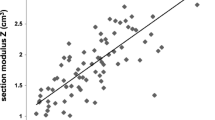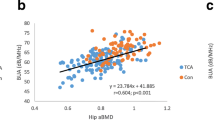Abstract
Summary
We conducted the first comparison of dual-energy X-ray absorptiometry (DXA) and peripheral quantitative computed tomography (pQCT) outcomes in adolescent girls with anorexia nervosa. We observed deficits in bone density by both tools. pQCT assessments were associated with many of the same clinical parameters as have been previously established for DXA.
Introduction
Adolescents with anorexia nervosa (AN) commonly exhibit bone loss, but effects on bone geometry are less clear. We compared measures obtained by DXA and pQCT in girls with AN.
Methods
Seventy females (age 15.5 ± 1.9 years ) with AN and 132 normal-weighted controls underwent tibial measures by pQCT including trabecular volumetric bone mineral density (vBMD) at the 3 % site, cortical vBMD and dimensions at the 38 % site, and muscle cross-sectional area (CSA) at the 66 % site. Participants with AN also underwent standard DXA measures. Independent t tests compared the pQCT results, while Pearson coefficient assessed correlations among DXA and pQCT measures.
Results
Trabecular vBMD Z-scores were lower in AN compared to controls (AN −0.31 ± 1.42 vs +0.11 ± 1.01, p = 0.01) and cortical vBMD Z-scores were higher (AN +0.18 ± 0.92 vs −0.50 ± 0.88, p < 0.001). Trabecular vBMD and cortical CSA Z-scores positively correlated with DXA BMD Z-scores (r range 0.57–0.82, p < 0.001). Markers of nutritional status positively correlated with Z-scores for trabecular vBMD, cortical CSA, section modulus, and muscle CSA (p < 0.04 for all).
Conclusions
This study is the first to compare DXA and pQCT measurements in adolescent girls with AN. We observed deficits in BMD by both DXA and pQCT. pQCT assessments correlated well with DXA bone and body composition measures and were associated with many of the same clinical parameters and disease severity markers as have been previously established for DXA. The differences in cortical vBMD merit further study.

Similar content being viewed by others
References
Smink FRE, van Hoeken D, Hoek HW (2012) Epidemiology of eating disorders: incidence, prevalence and mortality rates. Curr Psychiatry Rep 14(4):406–414
Donaldson A, Gordon CM (2015) Skeletal consequences of eating disorders. Metabolism. In press
Gordon CM, Goodman E, Emans SJ, et al. (2002) Physiologic regulators of bone turnover in young women with anorexia nervosa. J Pediatr 141(1):64–70
Soyka LA, Misra M, Frenchman A, et al. (2002) Abnormal bone mineral accrual in adolescent girls with anorexia nervosa. J Clin Endocrinol Metab 87(9):4177–4185
Klibanski A, Biller BM, Schoenfeld DA, Herzog DB, Saxe VC (1995) The effects of estrogen administration on trabecular bone loss in young women with anorexia nervosa. J Clin Endocrinol Metab 80(3):898–904
Soyka LA, Grinspoon S, Levitsky LL, Herzog DB, Klibanski A (1999) The effects of anorexia nervosa on bone metabolism in female adolescents. J Clin Endocrinol Metab 84(12):4489–4496
Misra M, Aggarwal A, Miller KK, et al. (2004) Effects of anorexia nervosa on clinical, hematologic, biochemical, and bone density parameters in community-dwelling adolescent girls. Pediatrics 114(6):1574–1583
Jagielska G, Wolanczyk T, Komender J, Tomaszewicz-Libudzic C, Przedlacki J, Ostrowski K (2002) Bone mineral density in adolescent girls with anorexia nervosa--a cross-sectional study. Eur Child Adolesc Psychiatry 11(2):57–62
Biller BM, Saxe V, Herzog DB, Rosenthal DI, Holzman S, Klibanski A (1989) Mechanisms of osteoporosis in adult and adolescent women with anorexia nervosa. J Clin Endocrinol Metab 68(3):548–554
Audi L, Vargas DM, Gussinye M, Yeste D, Marti G, Carrascosa A (2002) Clinical and biochemical determinants of bone metabolism and bone mass in adolescent female patients with anorexia nervosa. Pediatr Res 51(4):497–504
Turner JM, Bulsara MK, McDermott BM, Byrne GC, Prince RL, Forbes DA (2001) Predictors of low bone density in young adolescent females with anorexia nervosa and other dieting disorders. Int J Eat Disord 30(3):245–251
Rigotti NA, Neer RM, Skates SJ, Herzog DB, Nussbaum SR (1991) The clinical course of osteoporosis in anorexia nervosa. A longitudinal study of cortical bone mass. JAMA 265(9):1133–1138
Liu D, Manske SL, Kontulainen SA, et al. (2007) Tibial geometry is associated with failure load ex vivo: a MRI, pQCT and DXA study. Osteoporos Int 18(7):991–997
DiVasta AD, Beck TJ, Petit MA, Feldman HA, Leboff MS, Gordon CM (2006) Bone strength in adolescents with anorexia nervosa: a hip structural analysis study. Osteoporos Int
DiVasta AD, Feldman HA, Beck TJ, LeBoff MS, Gordon CM (2014) Does hormone replacement normalize bone geometry in adolescents with anorexia nervosa? J Bone Miner Res 29(1):151–157
Faje AT, Karim L, Taylor A, et al. (2013) Adolescent girls with anorexia nervosa have impaired cortical and trabecular microarchitecture and lower estimated bone strength at the distal radius. J Clin Endocrinol Metab 98(5):1923–1929
Wetzsteon RJ, Shults J, Zemel BS, et al. (2009) Divergent effects of glucocorticoids on cortical and trabecular compartment BMD in childhood nephrotic syndrome. J Bone Miner Res 24(3):503–513
Tsampalieros A, Griffin L, Terpstra AM, et al. (2014) Changes in DXA and quantitative CT measures of musculoskeletal outcomes following pediatric renal transplantation. Am J Transplant 14(1):124–132
Louis O, Clerinx P, Gies I, De Wachter E, De Schepper J (2009) Well-nourished cystic fibrosis patients have normal mineral density, but reduced cortical thickness at the forearm. Osteoporos Int 20(2):309–314
Mostoufi-Moab S, Magland J, Isaacoff EJ, et al. (2015) Adverse fat depots and marrow adiposity are associated with skeletal deficits and insulin resistance in long-term survivors of pediatric hematopoietic stem cell transplantation. J Bone Miner Res 30(9):1657–1666
Baker JF, Von Feldt J, Mostoufi-Moab S, et al. (2014) Deficits in muscle mass, muscle density, and modified associations with fat in rheumatoid arthritis. Arthritis Care Res (Hoboken) 66(11):1612–1618
Holick MF (2005) 25-OH-vitamin D assays. J Clin Endocrinol Metab 90(5):3128–3129
Hamwi GJ (1964) Therapy: changing dietary concepts. In: Danowski TS (ed) Diabetes mellitus: diagnosis and treatment. American Diabetes Association, New York, pp. 73–78
Organization WH (1995) Physical status: the use and interpretation of anthropometry. Report of a WHO Expert Committee, Geneva
Cole TJ (1990) The LMS method for constructing normalized growth standards. Eur J Clin Nutr 44(1):45–60
Zemel BS, Kalkwarf HJ, Gilsanz V, et al. (2011) Revised reference curves for bone mineral content and areal bone mineral density according to age and sex for black and non-black children: results of the bone mineral density in childhood study. J Clin Endocrinol Metab 96(10):3160–3169
Leonard MB, Elmi A, Mostoufi-Moab S, et al. (2010) Effects of sex, race, and puberty on cortical bone and the functional muscle bone unit in children, adolescents, and young adults. J Clin Endocrinol Metab 95(4):1681–1689
Griffin LM, Thayu M, Baldassano RN, et al. (2015) Improvements in bone density and structure during anti-TNF-α therapy in pediatric Crohn’s disease. J Clin Endocrinol Metab 100(7):2630–2639
Zou GY (2007) Toward using confidence intervals to compare correlations. Psychol Methods 12(4):399–413
Griffin LM, Kalkwarf HJ, Zemel BS, et al. (2012) Assessment of dual-energy X-ray absorptiometry measures of bone health in pediatric chronic kidney disease. Pediatr Nephrol 27(7):1139–1148
DiVasta AD, Feldman HA, Quach AE, Balestrino M, Gordon CM (2009) The effect of bed rest on bone turnover in young women hospitalized for anorexia nervosa: a pilot study. J Clin Endocrinol Metab 94(5):1650–1655
Tsampalieros A, Gupta P, Denburg MR, et al. (2013) Glucocorticoid effects on changes in bone mineral density and cortical structure in childhood nephrotic syndrome. J Bone Miner Res 28(3):480–488
Boskey AL, DiCarlo E, Paschalis E, West P, Mendelsohn R (2005) Comparison of mineral quality and quantity in iliac crest biopsies from high- and low-turnover osteoporosis: an FT-IR microspectroscopic investigation. Osteoporos Int 16(12):2031–2038
Davison KS, Siminoski K, Adachi JD, et al. (2006) Bone strength: the whole is greater than the sum of its parts. Semin Arthritis Rheum 36(1):22–31
Tommasini SM, Nasser P, Schaffler MB, Jepsen KJ (2005) Relationship between bone morphology and bone quality in male tibias: implications for stress fracture risk. J Bone Miner Res 20(8):1372–1380
Milos G, Spindler A, Ruegsegger P, et al. (2005) Cortical and trabecular bone density and structure in anorexia nervosa. Osteoporos Int 16(7):783–790
Leonard MB (2007) A structural approach to the assessment of fracture risk in children and adolescents with chronic kidney disease. Pediatr Nephrol 22(11):1815–1824
Seeman E, Karlsson MK, Duan Y (2000) On exposure to anorexia nervosa, the temporal variation in axial and appendicular skeletal development predisposes to site-specific deficits in bone size and density: a cross-sectional study. J Bone Miner Res 15(11):2259–2265
Gordon CM, Grace E, Emans SJ, et al. (2002) Effects of oral dehydroepiandrosterone on bone density in young women with anorexia nervosa: a randomized trial. J Clin Endocrinol Metab 87(11):4935–4941
Divasta AD, HA F, Giancaterino C, CJ R, MS L, CM G (2012) The effect of gonadal and adrenal steroid therapy on skeletal health in adolescents and young women with anorexia nervosa. Metabolism 61(7):1010–1020
Acknowledgments
The authors thank Alicia McAllister, RT, CBDT, Valerie Marsocci, RT, and Nicole DaSilva, RT, CNMT for technical assistance; the excellent care of the Boston Children’s Hospital Clinical and Translational Study Unit (CTSU) nurses; and our patients and their families, who made this research possible. Our study was supported by NIH R01 AR060829, NICHD K23 HD060066, NIH UL1 RR-025758 (Harvard Clinical and Translational Science Center), the Boston Children’s Hospital Department of Medicine and CTSU, and the Brown Alpert Medical School Department of Orthopaedics.
Author information
Authors and Affiliations
Corresponding author
Ethics declarations
The local institutional review boards approved the study protocol. Written informed consent was obtained from study patients or their parent/guardian. Minor subjects also provided assent for participation.
Conflicts of interest
None.
Rights and permissions
About this article
Cite this article
DiVasta, A.D., Feldman, H.A., O’Donnell, J.M. et al. Skeletal outcomes by peripheral quantitative computed tomography and dual-energy X-ray absorptiometry in adolescent girls with anorexia nervosa. Osteoporos Int 27, 3549–3558 (2016). https://doi.org/10.1007/s00198-016-3685-5
Received:
Accepted:
Published:
Issue Date:
DOI: https://doi.org/10.1007/s00198-016-3685-5




